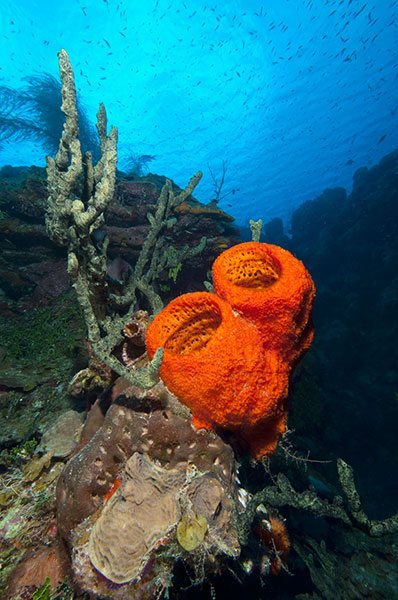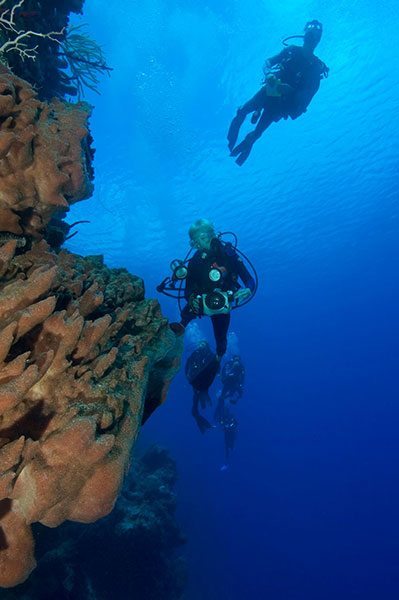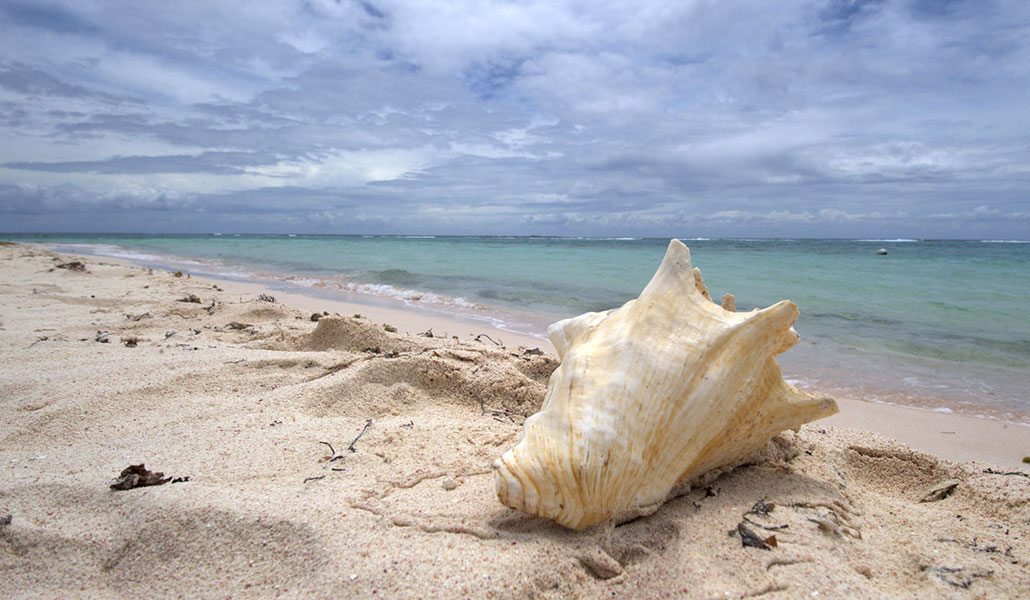In the movie “The Bucket List” two terminally ill men played by Morgan Freeman and Jack Nicholson create a wish list of things to do before they die. You certainly don’t have to be terminally ill to have such a list and as divers we have a “must dive” list that constantly grows as we read about locations worldwide that offer great diving. But there is one we have checked off our list yet return to year after year. It is Little Cayman. We are never disappointed and at the end of a visit we are always ready to plan for the next year’s visit. What is it that draws us back to this small island year after year? Well, in a word, the diving. The walls are breathtaking, the critters abundant and the reefs are healthy.
 History and Geography
History and Geography
In the northwestern Caribbean just 90 miles (144 km) south of Cuba sits a trio of relatively small islands that form the Cayman Islands. The three islands each have a unique topography and personality. Little Cayman, about 89 miles (143 km) from Grand Cayman and seven (11 km) miles from Cayman Brac, measures only 10 miles (16 km) long and barely reaches 40 feet (12 m) at its highest point and has a permanent population of fewer than 170 residents.
In 1503 Christopher Columbus, blown off course and on his final voyage to the New World, was the first to sight two small islands later known as Little Cayman and Cayman Brac. He named these islands “Las Tortugas” (The Turtles) for what was at the time a plentiful supply of turtle. Near the mid-1500s the islands were renamed “Caymanas,” derived from the Carib word for marine crocodiles. Sir Francis Drake reported sighting “great serpents … large like lizards, which are edible” on a 1585-86 voyage. Were these the iguanas that are still in residence on Little Cayman or a marine crocodile — a caiman — that was proven to exist at one time?
Due to the great quantity of turtle and available fresh water, the two smaller islands were popular hangouts for explorers and buccaneers. Some of the earliest settlers were from an English privateer navy that battled the Spanish hold in the Caribbean. The seafarers were legal pirates — the English government sanctioned piracy at the time as a way for the privateers to support themselves.
When peace was declared between the warring parties in the early 18th century, piracy was declared illegal. The British resolved to end the pirating, and dispatched ships and soldiers to Little Cayman. As the pirates tried to board their ships and escape, the British moved in. The bay where the battle took place is now called Bloody Bay.
Even when pirating ceased, life on Little Cayman was far from easy. Many of the men took to the sea as sailors and even today they are still well known around the world for their merchant seamen skills. Coconut farming was also attempted on Little Cayman but blight killed off the palms.
The island remained relatively quiet until tourism took off in the middle 1900s when U.S. sport fishermen discovered bonefishing on Little Cayman.
It wasn’t long before divers also discovered this tiny island as a hot dive destination. The lack of sediment and vegetation along the shorelines and the porous limestone cores provide amazing water clarity and makes for superb visibility year-round. Southern Cross Club was the first to offer diving facilities on Little Cayman.
With the influx of divers and fishermen came the growth of several modern resorts. Today Little Cayman offers a variety of accommodations and diving packages that will suit almost anyone’s needs.
 Sheer Walls and Critters Galore
Sheer Walls and Critters Galore
Year after year, Little Cayman is recognized as a top diving destination. The excellent visibility and dramatic walls are what keep this reputation intact. Although dive sites circle the island it’s the north side that is the real draw. Here in the Bloody Bay Marine Park you will find two spectacular wall systems: Bloody Bay Wall and Jackson’s Wall. The reef systems are easy to reach and are just a short boat ride from the south side where most of the resorts are located.
The diversity of dive sites on Little Cayman allows you to pick sites that will satisfy any level of diver. Currents are seldom strong, visibility typically exceeds 80 feet (24 m) and site depths can be as shallow as 15 feet (4.5 m). Although Little Cayman is not known for shore diving, there are several accessible dive sites from shore. The sites are not marked from the road but the resorts or car rental agency can point out the most popular ones. These sites are also excellent for snorkelers. In general the wall dives are best accessed by boat. If you plan to boat dive, call ahead for reservations. Most dive centers cater to small groups.
The top of Bloody Bay Wall comes to within 15 feet of the surface and its face is a steep sheer cliff. Here you will often see eagle rays and sharks cruising along in the deep blue, while closer to the wall, turtles, eels and countless other marine critters cavort among the healthy and colorful sponges and coral. The sheerness of the wall is evident at dive sites Great Wall East and West. Prepare to suck in some air as you drop in and see the endless blue go on and on: water depths here can reach to more than 3,000 feet (909 m) just a couple of miles off shore. Corals and sponges stick out at 90-degree angles from the steep wall so buoyancy is important as is not letting your fins kick anything.
As you move east toward Jackson’s Wall, the wall transitions from the sheer drop-off experienced on Bloody Bay Wall to a more gradual sloping fore reef backed by a second “miniwall” and separated by an open flat sandy channel. One of our favorite sites in Little Cayman is Mixing Bowl where Bloody Bay Wall and Jackson Wall meet. Here you will see the wall transition from a sheer drop-off to a more gradual slope. On the sheer wall you will often see turtles or sharks, while back in the sand behind the fore reef you’ll see plenty of cleaning stations, jawfish, shrimps and crabs.
Between Dives
Although diving is probably the highlight of visiting Little Cayman there are other activities to keep you amused during your downtime. We have found one of the best ways to tour Little Cayman is to grab a courtesy bicycle from your resort and head off to see the sights. Along the way you are likely to see land iguanas sunning themselves along the roadside. Little Cayman is home to the largest iguana population — about 2,000 — in the Cayman Islands. Iguanas are so plentiful on the island that “Iguana Crossing” signs are posted as a reminder to slow down and keep an eye out for these prehistoric-looking creatures.
A must-see on your tour is the Booby Pond Nature Reserve. This landlocked saltwater lagoon surrounded by mangroves provides a habitat for many types of wetland and shore birds, and a high diversity of native plants. The reserve is home to the Caribbean’s largest known nesting colony of red-footed boobies and the Caymans Islands’ only breeding colony of magnificent frigatebirds. Stop in at the visitors center and with any luck their delicious homemade ice cream will be on sale.
For those who may really want a beach to themselves, catch a ride or rent a car and head to Point of Sand where you can catch a glimpse of Cayman Brac just a short distance away. The beautiful white sand is a great place to enjoy a picnic and the clear shallow waters are perfect for a long relaxing snorkel.
Fishing is also a favorite pastime on Little Cayman. There is bonefishing on the coastal flats and deep-sea fishing off the walls. Tarpon Lake in Little Cayman is populated with some impressive 10- to 15-pound (4.5- to 7-kg) tarpon. Many light tackle and fly fishermen come here seeking a “grand slam” — a catch-and-release that consists of a tarpon, a permit and a bonefish landed on the same day.
Accommodations, Restaurants and Getting Around
Little Cayman offers several types of accommodations that should suit anyone’s needs. Hotels, condominiums and private homes are all available. The majority of the dive resorts are small and typically offer all-inclusive options. The restaurants are primarily within the resorts. If you stay in a private home and want to eat out make sure you call ahead for reservations. There is a general store near the airport where you can pick up supplies and smaller items you may have forgotten. Most of the resorts offer bicycles to their customers at no charge and there is one Jeep rental agency on the island.
Just No Place Like It
There are two kinds of divers that visit Little Cayman — those who return and those who will return. This island offers up some of the biggest dive adventures you will find in the Caribbean. The resorts are small and inviting, the dive operations are experienced and service-oriented and the locals are helpful and friendly. If you are looking for a most memorable dive vacation, then consider putting Little Cayman on the top of your list.





